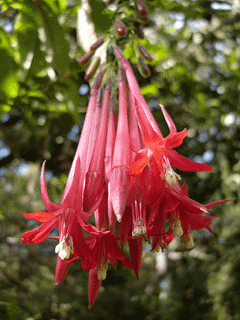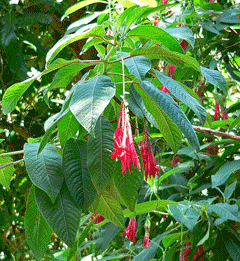 |
|
http://commons.wikimedia.org/wiki/User:Bouba |
 |
| http://commons.wikimedia.org/wiki/User:Stan_Shebs |
Translate this page:
Summary
Physical Characteristics

 Fuchsia boliviana is an evergreen Shrub growing to 3.5 m (11ft) by 1 m (3ft 3in) at a fast rate.
Fuchsia boliviana is an evergreen Shrub growing to 3.5 m (11ft) by 1 m (3ft 3in) at a fast rate.
See above for USDA hardiness. It is hardy to UK zone 10 and is frost tender. It is in leaf all year, in flower from June to September, and the seeds ripen from August to October. The species is hermaphrodite (has both male and female organs) and is pollinated by Bees, birds.
Suitable for: light (sandy), medium (loamy) and heavy (clay) soils and prefers well-drained soil. Suitable pH: mildly acid, neutral and basic (mildly alkaline) soils. It can grow in semi-shade (light woodland) or no shade. It prefers moist soil.
UK Hardiness Map
US Hardiness Map
Synonyms
Plant Habitats
Woodland Garden Sunny Edge; Dappled Shade; East Wall. By.
Edible Uses
Edible Parts: Fruit
Edible Uses:
Fruit - raw[48, 177, 200]. A juicy berry[K], it has a sweetish taste[97, 183]. A pleasant flavour[188]. The fruit can be up to 25mm long[200].
References More on Edible Uses
Medicinal Uses
Plants For A Future can not take any responsibility for any adverse effects from the use of plants. Always seek advice from a professional before using a plant medicinally.
None known
References More on Medicinal Uses
The Bookshop: Edible Plant Books
Our Latest books on Perennial Plants For Food Forests and Permaculture Gardens in paperback or digital formats.

Edible Tropical Plants
Food Forest Plants for Hotter Conditions: 250+ Plants For Tropical Food Forests & Permaculture Gardens.
More

Edible Temperate Plants
Plants for Your Food Forest: 500 Plants for Temperate Food Forests & Permaculture Gardens.
More

More Books
PFAF have eight books available in paperback and digital formats. Browse the shop for more information.
Shop Now
Other Uses
References More on Other Uses
Cultivation details
Succeeds in any fertile well-drained circum-neutral soil[200]. Requires a good open humus-rich soil and a moist partially shady position in the summer[48, 260]. A fast-growing plant[188]. Plants are not very hardy outdoors in Britain. They are susceptible to frost damage at temperatures of 0°c[260], though they can be grown outdoors in the summer, then lifted and potted up in the greenhouse for the winter[48]. They can succeed outdoors in the mildest areas of the country if they are given the protection of a wall[166]. A plant in a sheltered wall garden at Trengwainton in Cornwall was 2 metres tall and flowering very freely in August 1995, though there was little fruit set[K]. Plants are evergreen so long as the temperature remains above 4°c[188]. Plants are very susceptible to whitefly when grown in a greenhouse[188]. This species is closely related to F. corymbiflora[1]. Plants seem to be immune to the predations of rabbits[233]. A good bee plant[108]. This species has a long tubular flower and is pollinated by humming birds in the wild[260].
References Carbon Farming Information and Carbon Sequestration Information
Temperature Converter
Type a value in the Celsius field to convert the value to Fahrenheit:
Fahrenheit:
The PFAF Bookshop
Plants For A Future have a number of books available in paperback and digital form. Book titles include Edible Plants, Edible Perennials, Edible Trees,Edible Shrubs, Woodland Gardening, and Temperate Food Forest Plants. Our new book is Food Forest Plants For Hotter Conditions (Tropical and Sub-Tropical).
Shop Now
Plant Propagation
Seed - best sown as soon as it is ripe[200] though it can also be sown in the spring[1]. Surface sow the seed in pots in a warm greenhouse and do not allow the compost to dry out[200]. Germination should take place in less than 6 weeks. Prick out the seedlings into individual pots when they are large enough to handle, and grow them on in the greenhouse for at least their first winter. Plant out in late spring or early summer, after the last expected frosts. Inter-nodal cuttings of greenwood, 5 - 8cm long, May/June in a frame. Quick and easy, a high percentage take[78, K]. Overwinter in the greenhouse for the first year and plant out after the last expected frosts. Inter-nodal cuttings of half-ripe wood, July/August in a frame. Very quick and easy, treat as greenwood cuttings above[K]. Cuttings usually succeed at any time during the growing season[K].
Other Names
If available other names are mentioned here
Native Range
SOUTHERN AMERICA: Bolivia, Peru (south), Argentina (Catamarca, Jujuy, Salta, Tucumán)
Weed Potential
Right plant wrong place. We are currently updating this section.
Please note that a plant may be invasive in one area but may not in your area so it's worth checking.
Conservation Status
IUCN Red List of Threatened Plants Status :

Growth: S = slow M = medium F = fast. Soil: L = light (sandy) M = medium H = heavy (clay). pH: A = acid N = neutral B = basic (alkaline). Shade: F = full shade S = semi-shade N = no shade. Moisture: D = dry M = Moist We = wet Wa = water.
Now available:
Food Forest Plants for Mediterranean Conditions
350+ Perennial Plants For Mediterranean and Drier Food Forests and Permaculture Gardens.
[Paperback and eBook]
This is the third in Plants For A Future's series of plant guides for food forests tailored to
specific climate zones. Following volumes on temperate and tropical ecosystems, this book focuses
on species suited to Mediterranean conditions—regions with hot, dry summers and cool, wet winters,
often facing the added challenge of climate change.
Read More
Expert comment
Author
Carrière.
Botanical References
200
Links / References
For a list of references used on this page please go here
Readers comment
| Add a comment |
|
If you have important information about this plant that may help other users please add a comment or link below. Only comments or links that are felt to be directly relevant to a plant will be included. If you think a comment/link or information contained on this page is inaccurate or misleading we would welcome your feedback at [email protected]. If you have questions about a plant please use the Forum on this website as we do not have the resources to answer questions ourselves.
* Please note: the comments by website users are not necessarily those held by PFAF and may give misleading or inaccurate information.
To leave a comment please Register or login here All comments need to be approved so will not appear immediately.
|
Subject : Fuchsia boliviana
|
|
|
|